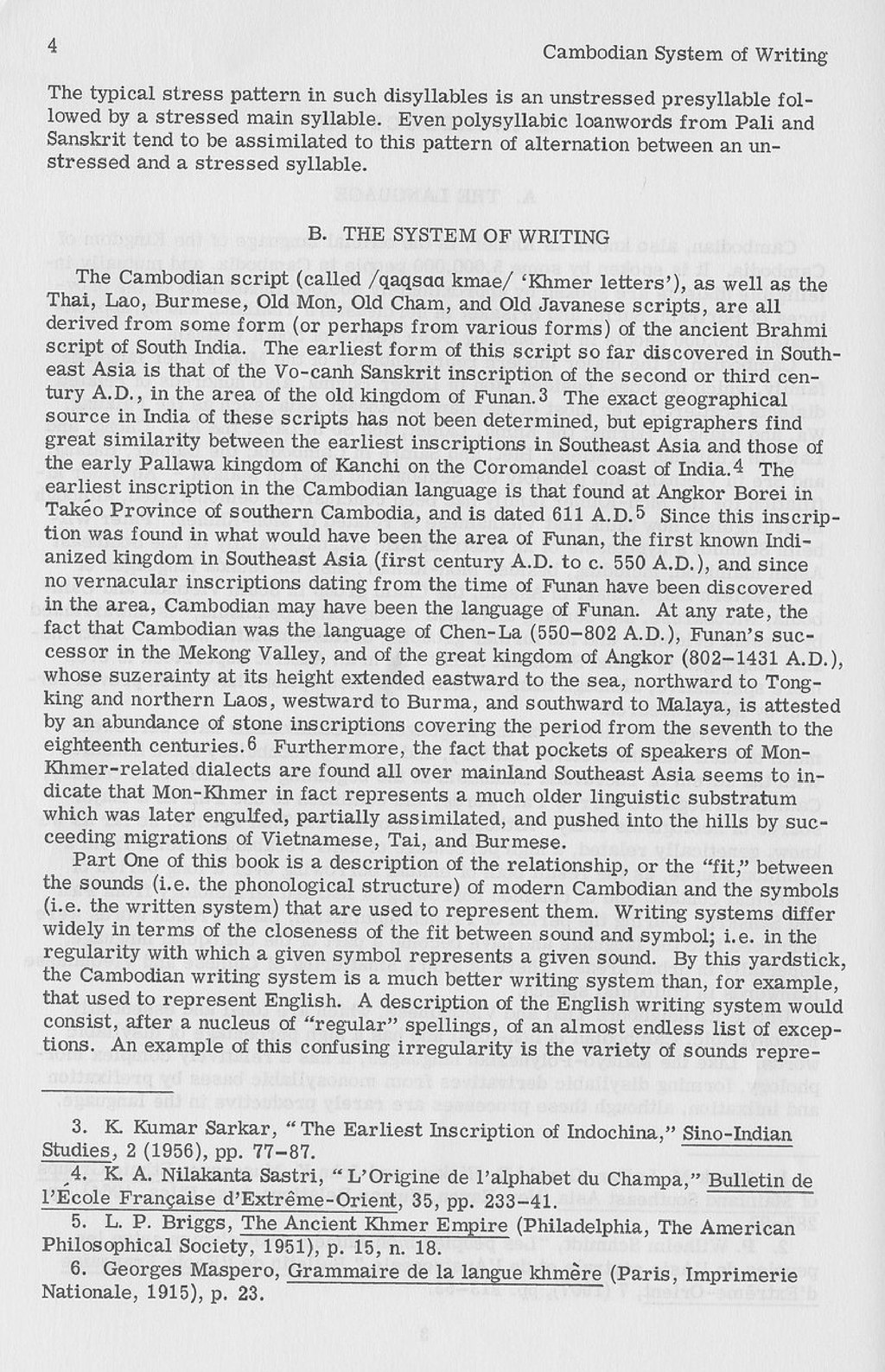The typical stress pattern in such disyllables is an unstressed presyllable followed by a stressed main syllable. Even polysyllabic loanwords from Pali and Sanskrit tend to be assimilated to this pattern of alternation between an unstressed and a stressed syllable.
B. THE SYSTEM OF WRITING
The Cambodian script (called /qaqsɑɑ kmae/ ‘Khmer letters’), as well as the Thai, Lao, Burmese, Old Mon, Old Cham, and Old Javanese scripts, are all derived from some form (or perhaps from various forms) of the ancient Brahmi script of South India. The earliest form of this script so far discovered in Southeast Asia is that of the Vo-canh Sanskrit inscription of the second or third century A.D., in the area of the old kingdom of Funan.[1] The exact geographical source in India of these scripts has not been determined, but epigraphers find great similarity between the earliest inscriptions in Southeast Asia and those of the early Pallawa kingdom of Kanchi on the Coromandel coast of India.[2] The earliest inscription in the Cambodian language is that found at Angkor Borei in Takéo Province of southern Cambodia, and is dated 611 A.D.[3] Since this inscription was found in what would have been the area of Funan, the first known Indianized kingdom in Southeast Asia (first century A.D. to c. 550 A.D.), and since no vernacular inscriptions dating from the time of Funan have been discovered in the area, Cambodian may have been the language of Funan. At any rate, the fact that Cambodian was the language of Chen-La (550–802 A.D.), Funan’s successor in the Mekong Valley, and of the great kingdom of Angkor (802–1431 A.D.) whose suzerainty at its height extended eastward to the sea, northward to Tong-king and northern Laos, westward to Burma, and southward to Malaya, is attested by an abundance of stone inscriptions covering the period from the seventh to the eighteenth centuries.[4] Furthermore, the fact that pockets of speakers of Mon-Khmer-related dialects are found all over mainland Southeast Asia seems to indicate that Mon-Khmer in fact represents a much older linguistic substratum which was later engulfed, partially assimilated, and pushed into the hills by succeeding migrations of Vietnamese, Tai, and Burmese.
Part One of this book is a description of the relationship, or the “fit,” between the sounds (i.e. the phonological structure) of modern Cambodian and the symbols (i.e. the written system) that are used to represent them. Writing systems differ widely in terms of the closeness of the fit between sound and Symbol; i.e. in the regularity with which a given symbol represents a given sound. By this yardstick the Cambodian writing system is a much better writing system than, for example, that used to represent English. A description of the English writing system would consist, after a nucleus of “regular” spellings, of an almost endless list of exceptions. An example of this confusing irregularity is the variety of sounds repre-
- ↑ K. Kumar Sarkar (1956). "The Earliest Inscription of Indochina". Sino-Indian Studies 2: 77–87.
- ↑ K. A. Nilakanta Sastri. "L’Origine de l’alphabet du Champa". Bulletin de l’École Française d’Extrême-Orient 35: 233–41.
- ↑ L. P. Briggs (1951). The Ancient Khmer Empire. Philadelphia: The American Philosophical Society. p. 15, n. 18.
- ↑ Georges Maspero (1915). Grammaire de la langue khmère. Paris: Imprimerie Nationale. p. 23.
